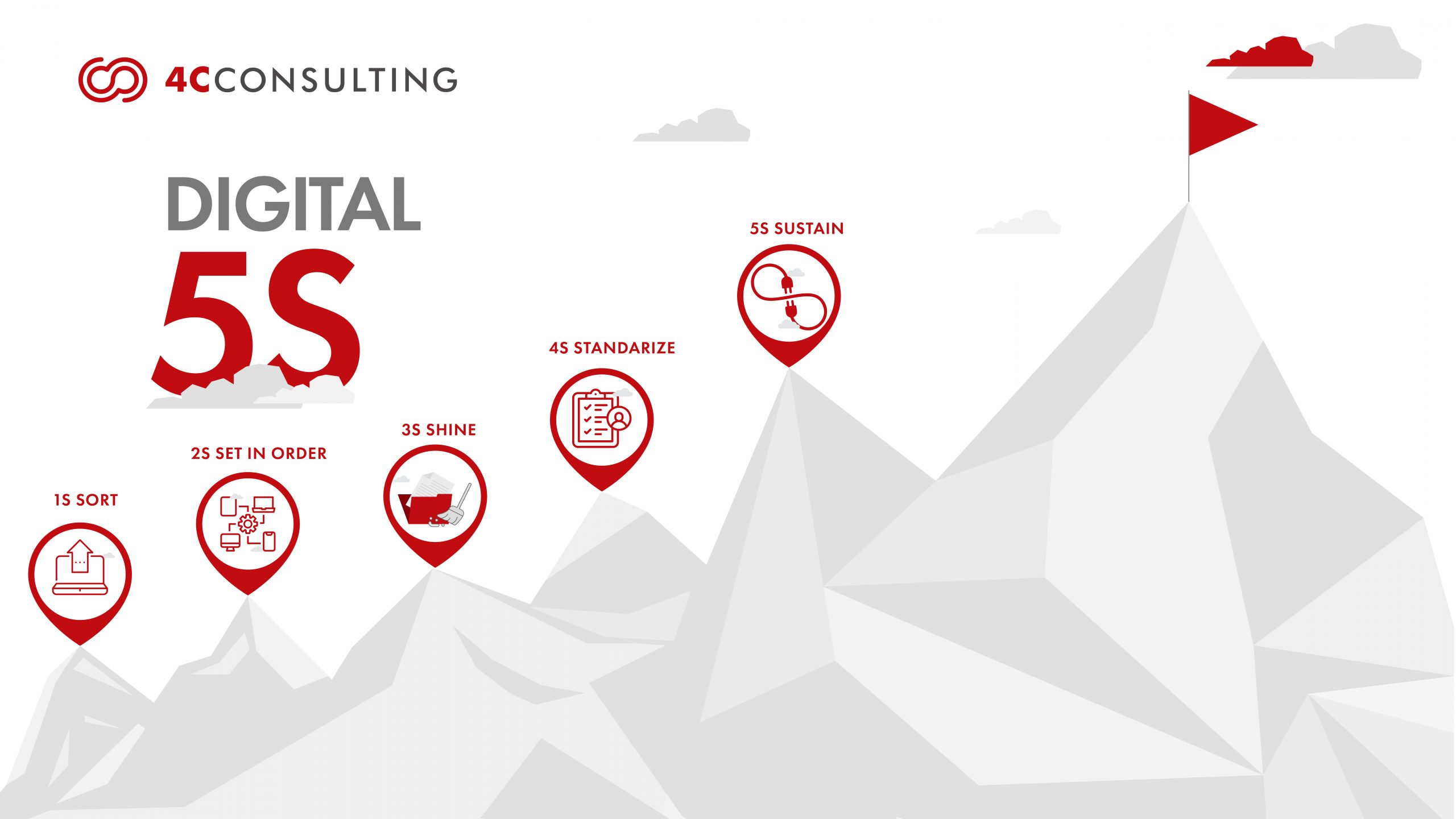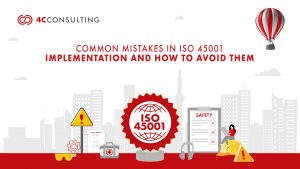
IMPLEMENTING 5S METHODOLOGY IN THE DIGITAL WORKPLACE
5th Jul, 2024
In the digital age, maintaining an organized and efficient workspace is essential for productivity and success. The 5S methodology, which originated in Japan, has traditionally been a cornerstone of manufacturing and lean management. However, its principles are equally applicable to digital work environments. This blog explores how to implement the 5S methodology in the digital workplace, highlighting its importance and the numerous benefits it brings to modern organizations. By applying 5S principles businesses can enhance their digital workspaces, leading to increased efficiency, reduced errors, and improved overall performance. Embracing 5S in the digital realm fosters a culture of continuous improvement, ensuring that organizations stay agile and competitive in today’s fast-paced, technology-driven world.
.
WHAT IS 5S?
The 5S methodology comprises five principles designed to create and maintain an organized, efficient, and safe workplace. These principles, which originated from Japanese manufacturing practices, have been successfully adapted across various industries worldwide. When applied to digital environments, 5S can transform the management of digital assets and workflows, leading to streamlined operations, enhanced productivity, and a culture of continuous improvement.
The principles are as follows:
- Sort (Seiri): Removing unnecessary items from the workspace.
- Set in Order (Seiton): Organizing essential items for easy access.
- Shine (Seiso): Cleaning the workspace and maintaining its cleanliness.
- Standardize (Seiketsu): Establishing standards and procedures to maintain organization.
- Sustain (Shitsuke): Ensuring continuous improvement and adherence to the standards.
Each of these principles is crucial in fostering a disciplined and efficient digital workspace. By systematically eliminating clutter, organizing essential tools, maintaining cleanliness, establishing clear standards, and promoting continuous improvement, organizations can achieve significant gains in efficiency and performance. This structured approach not only helps in managing physical spaces but also offers a robust framework for digital workspace management, ensuring that digital tools and resources are used optimally. Implementing the 5S methodology in your digital environment can lead to increased productivity, reduced errors, and improved overall performance, making it an essential strategy for modern organizations.
.
Drive Operational Discipline and Efficiency with 5S in Digital Teams.
IMPORTANCE OF 5S IN MODERN DIGITAL ENVIRONMENTS
The digital workplace presents unique challenges and opportunities for implementing 5S. With the increasing reliance on digital tools and resources, maintaining an organized and efficient digital environment is crucial. Applying 5S principles to digital workspaces can enhance productivity, reduce errors, and improve overall efficiency. By systematically organizing digital assets, establishing clear procedures, and promoting continuous improvement, businesses can optimize their digital workflows and create a more productive and streamlined working environment. This approach not only boosts operational efficiency but also supports better collaboration and innovation in the digital realm.
IMPLEMENTING 5S PRINCIPLES IN THE DIGITAL WORKPLACE
1. Sort – Organizing Digital Assets
The 5 principles of 5S also known as 5 steps of 5S Implementation the very first step in implementing 5S in the digital workplace is sorting digital assets. This involves identifying and removing unnecessary files, emails, and applications that clutter the workspace.
- Identify Unnecessary Files: Conduct a thorough audit of all digital assets, including documents, emails, and software. Identify and delete or archive items that are no longer needed. This step is vital in reducing digital clutter and improving accessibility to relevant files. By removing outdated or irrelevant information, you can streamline your digital workspace and focus on what truly matters.
- Categorize and Label: Organize remaining files into categories and label them appropriately. Use a consistent naming convention to make searching and retrieval easier. Implementing a structured system for file organization can significantly reduce the time spent searching for documents. Ensure that folders are logically named and hierarchically arranged.
- Digital Red Tags: Similar to physical 5S, use digital red tags to mark files for deletion or archiving. This helps in systematically sorting through large volumes of data. Regularly review tagged files to ensure that they are either properly archived or deleted, maintaining a clean digital environment.
.
2. Set in Order – Structuring Digital Workflows
Once unnecessary items are removed, the next step is to set in order the remaining digital assets and workflows. This ensures that everything is organized and easily accessible.
- Create a Logical Folder Structure: Develop a clear and logical folder structure for storing digital files. Group similar items together and use descriptive folder names. A well-organized folder structure facilitates quick access to necessary documents and reduces the time spent navigating through complex directory systems.
- Standardize File Naming Conventions: Establish and adhere to consistent file naming conventions to ensure uniformity and ease of access. Consistent naming conventions help avoid confusion and ensure that files can be easily located by any team member.
- Utilize Digital Tools: Make use of digital tools and software to automate and streamline workflows. Tools like project management software, cloud storage, and collaboration platforms can enhance organization and efficiency. Leveraging technology to automate routine tasks can significantly boost productivity and reduce the risk of human error.
.
3. Shine – Maintaining a Clean Digital Environment
Maintaining a clean digital environment involves regular cleaning and maintenance of digital assets and systems.
- Regular Clean-up: Schedule regular clean-up sessions to delete unnecessary files, clear caches, and remove outdated software. Regular maintenance prevents digital clutter from accumulating and ensures that your systems remain efficient.
- Update and Patch Software: Ensure that all software and applications are up-to-date with the latest patches and updates to maintain security and performance. Keeping software updated is crucial for protecting against security vulnerabilities and ensuring optimal performance.
- Monitor and Optimize: Continuously monitor digital systems for performance issues and optimize them to ensure smooth operation. Regularly review system performance metrics and make necessary adjustments to enhance efficiency.
.
4. Standardize – Establishing Digital Standards and Procedures
Standardization is key to maintaining consistency and efficiency in the digital workplace.
- Develop Standard Operating Procedures (SOPs): Create SOPs for common digital tasks and processes. Document best practices and ensure that all team members are aware of and follow these procedures. SOPs provide clear guidelines and help maintain a consistent approach to digital tasks across the organization.
- Use Templates and Checklists: Develop templates and checklists for recurring tasks to ensure consistency and reduce errors. Templates and checklists standardize processes and ensure that essential steps are not overlooked.
- Training and Awareness: Provide training and awareness programs to educate employees on digital standards and best practices. Regular 5S training sessions ensure that all team members are up-to-date with the latest practices and can effectively implement the 5S methodology.
.
5. Sustain – Ensuring Continuous Improvement in Digital Workspaces
The final step in the 5S methodology is sustaining the improvements and ensuring continuous adherence to the standards.
- Regular Audits and Reviews: Conduct regular audits and reviews to ensure compliance with established standards and procedures. Use digital 5S audits to identify areas for improvement. Regular audits help maintain high standards and identify areas where further improvements can be made.
- Encourage Feedback and Suggestions: Foster a culture of continuous improvement by encouraging employees to provide feedback and suggestions for enhancing digital workflows. Open communication channels allow for the sharing of ideas and innovative solutions.
- Celebrate Successes: Recognize and celebrate successes and improvements in the digital workplace to motivate employees and reinforce the importance of 5S principles. Acknowledging achievements boosts morale and encourages continued adherence to the 5S methodology.
.
BENEFITS OF APPLYING 5S PRINCIPLES TO DIGITAL WORKSPACES
Implementing 5S in the digital workplace offers numerous benefits, including:
- Increased Productivity: An organized digital workspace enhances productivity by reducing time spent searching for files and information. Employees can focus on their tasks without unnecessary interruptions caused by disorganization.
- Improved Efficiency: Streamlined workflows and standardized procedures lead to improved efficiency and reduced errors. Consistency in processes ensures that tasks are completed accurately and promptly.
- Enhanced Security: Regular maintenance and updates ensure that digital systems are secure and protected from threats. Keeping systems updated reduces the risk of data breaches and ensures compliance with security protocols.
- Better Collaboration: Clear organization and easy access to digital assets facilitate better collaboration among team members. An organized digital environment supports seamless communication and teamwork.
- Cost Savings: Efficient use of digital resources and elimination of unnecessary software can lead to cost savings. Reducing redundant software and optimizing resource allocation can significantly cut costs.
Implementing the 5S methodology in the digital workplace is crucial for modern organizations seeking to boost efficiency, productivity, and overall performance. By sorting, setting in order, shining, standardizing, and sustaining digital assets and workflows, businesses can cultivate a more organized and effective digital environment.
Embracing 5S principles in the digital realm enhances operational efficiency and fosters a culture of continuous improvement and excellence. Adhering to these guidelines transforms digital workspaces into streamlined, efficient, and productive environments. This approach benefits individual employees and contributes to the organization’s overall success and competitiveness in today’s digital landscape.
.
HOW CAN 4C HELP YOU IMPLEMENT THE 5S METHODOLOGY IN YOUR DIGITAL WORKPLACE?
Our 4C team includes 15+ years experienced consultants specializing in the 5S methodology for digital workplaces, ensuring a seamless transition to enhanced productivity. With a proven track record of implementing 5S in over 100+ digital environments & 10000+ hours of 5S training, we have mastered the art of creating organized and efficient digital workflows. Our expertise allows us to streamline operations, reduce clutter, and boost overall performance, leveraging innovative techniques that simplify the implementation process. Elevate your business by improving digital workspace organization and operational efficiency – contact our experts today.



